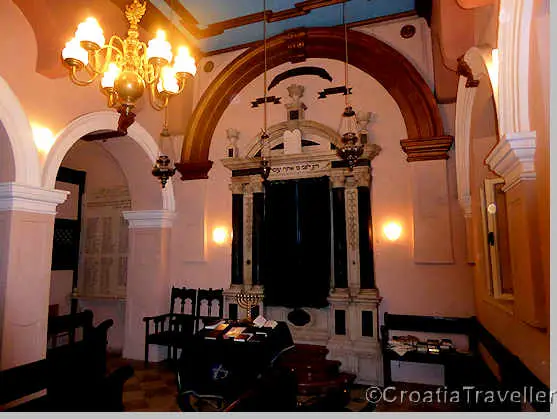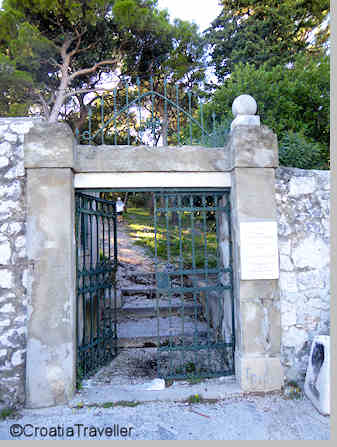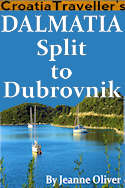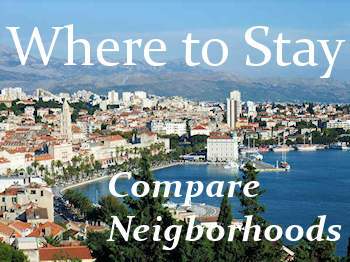Synagogue
Split's synagogue at Zidovski prolaz 1 is the world's second oldest Sephardic synagogue still in use (the oldest one is in Dubrovnik). Built right onto the western wall of Diocletian's Palace, the synagogue is tucked onto the second floor of two medieval houses that had been joined together in the heart of Split's former Jewish ghetto. Here the streets are as narrow as alleys.
Behind the plain wooden door, the tiny synagogue sparkles with a brass chandelier and silver lamps while the graceful arches and blue painted ceiling are enchanting. The aron hakodesh, flanked by elegant black and white marble pillars, is actually built into the western wall of Diocletian's Palace.

To the left is a plaque inscribed with the names of Split's Jews who perished in the Holocaust. Another plaque memorializes those Jews who fought with Tito's Liberation Army. The mixture of surnames on the plaques from Papo, Finzi and Elazar to Schwartz, Levi and Davidson shows the extent to which Split blended Sephardic and Ashkenazy communities.
Although the Jewish community has been present in Split since its founding in the 7th century, this synagogue was built in the 16th century and renovated in 1728. Tragically, the old synagogue's archives, furniture and religious objects were set aflame in the town square by fascists in 1942. Anything not burned was stolen including the sacred silver and vestments.
Opening Hours
The synagogue is open 10am to 2pm Monday to Friday.
Jewish History in Split
Before Split there was the Roman city of Salona, the wealthy capital of the Roman province of Dalmatia, that endured until the 7th century. Numerous archaeological finds from a cemetery testify to the Jewish presence in Salona, including a Jewish pendant, ceramic oil lamps and a fragment of a Jewish sarcophagus now displayed in the Archaeological Museum of Split.
When Salona fell to Avar invasions, the survivors, including Jews, took refuge within the fortified palace constructed by Emperor Diocletian. Thus, the city of Split was born. The Jewish migrants sheltered in the basement halls of Diocletian's Palace, etching menorahs into the eastern vaults to claim it as a place of worship. They are still visible today.
Although few records survive of the succeeding centuries, it appears that the earliest Jews constructed a synagogue in the southern part of the palace. Until the 16th century, that part of the city was called Synagogue. The great fire of 1507 forced the community to resettle in the northwest corner of the palace
The medieval Jewish community were referred to as zueca, a term often applied to tanners and dyers, which must have been their predominant occupation for many centuries. Unlike in many European towns during this period, the Jews were integrated into the community and did not suffer persecution or pogroms.
The expulsion of Jews from the Iberian peninsula at the end of the 15th century brought new life and new commercial opportunities to the Jewish community, largely thanks to a Spanish Jew named Daniel Rodriga. Split had been part of the Venetian empire since the beginning of the century and by the middle of the century Venice had become worried that new sea routes between East and West were undermining her trade hegemony. Rodriga proposed that Split operate as a way station for trade between Europe and the Orient. His plan was that goods could be carried overland from the Orient to Split and then shipped to Venice and he managed to procure funds from the Doge to implement his project. A quarantine (lazaretto) for Europe-bound goods would be built in Split's port and Jewish merchants, with strong commercial links to the Levant, would be granted special dispensations to encourage them to reside and trade within the Venetian empire.
His plan was a stunning success bringing prosperity to Split and solidifying the status of Jews in Split and elsewhere in the Venetian empire. Rodriga was so revered for his contribution to Split history, that a charming old street near the synagogue is named Rodrigina ulica.
At the end of the 15th century, the Jewish community in Split expanded when the Spanish Jews fleeing the Inquisition arrived. The number of Jews probably never topped 300 but they played a vital role in the local economy. Profiting from the new East-West trade, many were retailing imported goods. They were also weavers, tailors, grocers, physicians and surgeons. They even won approval to run a bank.
During the Turkish attack in 1657 the Jews were assigned the defense of a tower which later became known as the Jewish position [posto degl' Ebrei]. The northwest tower of the palace is still known as Zidovska Kula (Jewish Tower).
Unlike Dubrovnik, a ghetto did not exist until the late 18th century when the decline of Venice and the growing influence of the Church prompted the establishment of the ghetto in the northwestern part of the city. As the Venetian Republic crumbled, extremists in the city attacked the ghetto in 1797 but the populace soon dissuaded them from violence. The arrival of the French in 1805 brought a "Declaration of Civil Rights" which extended all civil rights to the Jews although some rights were eventually curtailed when the Austrians took power again in 1813.
The 19th century passed peacefully in Split as Jews and Christians worked and lived harmoniously together. Several prominent Jewish citizens became noted scholars at home and abroad, and one in particular, Vid Morpurgo, played an important role in spreading the revival of Croatian political consciousness in Dalmatia. When Split's port declined in importance at the end of the century many of the wealthier Jewish citizens left to pursue other opportunities, mainly in Trieste. Their places were filled by other Jewish families fleeing persecution in Bosnia.
The outbreak of WWII put an end to over a thousand years of peaceful Jewish integration into Split. Although the local population attempted to protect Jews in their midst, that project was easier under the Italians than the Germans. The Italians introduced harsh restrictions upon the Jewish population; the synagogue was demolished; Jewish shops were plundered and Jewish people beaten. But the Italians did not deport. When Italy capitulated and Germans moved upon Split many Jewish men joined the Liberation Army (Partizans) under Marshal Tito but those who could not, as well as the elderly, infirm and women were left to the Germans. Some were shot on the spot. Others were sent to Auschwitz or other concentration camps. In total, 148 Split Jews perished in the Holocaust.
The Jewish community in Split today numbers about 100 people. Although the synagogue does not have a permanent rabbi, religious and social events are held regularly. See the Jewish Community of Split website.
Jewish Cemetery
It was Daniel Rodriga who pushed for a Jewish cemetery in Split. His request was granted and a Jewish cemetery was opened in 1573 on Marjan Hill. It's one of the world's oldest Jewish cemeteries and contains around 700 tombstones, some with Sephardic script. To find it, climb the stairs on Senjska from Sperun in the Veli Varos neighbourhood. The cemetery is next to popular Vidilica cafe, a former mikvah or funeral home, still inscribed with the Jewish prayer, Tziduk HaDin, at the entrance. The cemetery is usually open but if locked ask at Vidilica for the key.

Jewish Heritage Map
Further Resources
More in Croatia Traveller's Dalmatia: Split to Dubrovnik Related Pages
|
Join the Croatia Traveller Group
Recommended Experiences
©CroatiaTraveller 2005-2024 All rights reserved


